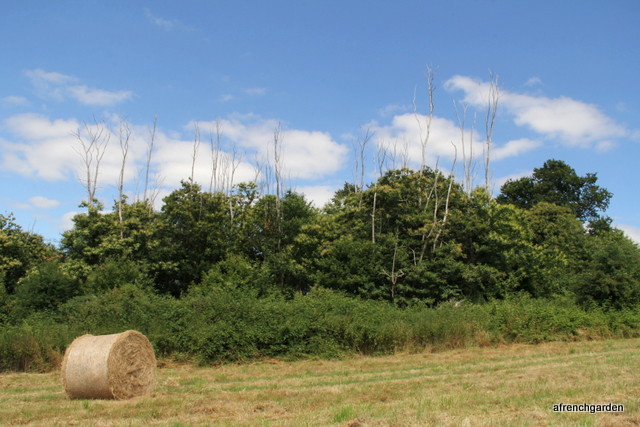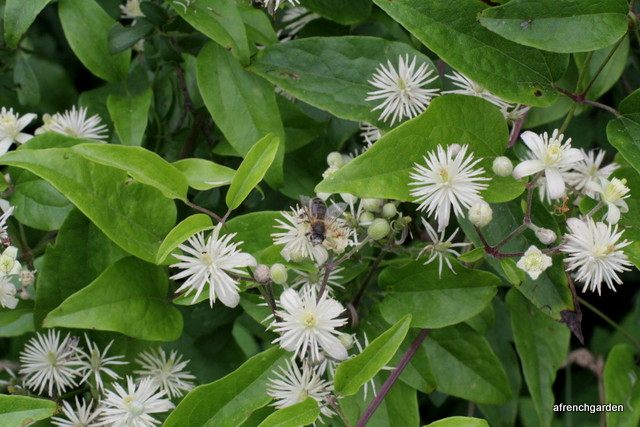Last week I was very worried about the bees. We are new to beekeeping and we visit the girls everyday (often more than once) just to see how they are getting on as you can learn a lot by just watching them.
However, I noticed a strange odour around the beehives and Kourosh confirmed that he could smell it too. When it lasted more than a day or too I began to recall bee diseases that had unpleasant odours attached to them. However, the bees were doing so well and the odour, although unusual, was not unpleasant. In fact, it smelt familiar but I could not place it.
It was not until we went for a walk into the woods that I traced the source of the perfume (?). We had been watching the Sweet Chestnuts (Castanea sativa) throw out the unripe catkins and knew that the flowering was imminent but we had never suspected that the bees could bring so much pollen back that we would be able to smell it in front of the hives.
The male flowers produce long stamens and the quantity of pollen produced by the tree is enormous. One method of testing to see what type of honey that the bees produce is to examine the pollen grains trapped inside the honey. However, the quantity of pollen produced by the sweet chestnut can complicate the analysis and I have read that some honeys in France which are 100% Latifolia (the commercially grown lavender for perfume, essential oils etc.) and, therefore, monofloral could containe 80% of sweet chestnut pollen!
We are lucky to be surrounded by woods containing Sweet Chestnut trees so the bees are happy just now and we are happy to collect the chestnuts in the autumn.
The female flowers which are tiny and insignificant in comparison to the stamens of the male flower. After receiving comments provoked by the Facebook page of the BBKA I need to clarify where the nectaries of the Sweet Chestnut trees are situated. I have found a paper in which one of the main criteria was to study the morphology of Sweet Chestnut flowers. ( Flower morphology of Castanea sativa Mill From Bulgaria and characteristics of unifloral chestnut honey ( Comptes rendus de l’Académie bulgare des sciences: sciences mathématiques et naturelles · January 2013.Juliana Atanassova, Spassimir Tonkov (Submitted by Academician V. Golemansky on April 19, 2013)) This paper quoted, as a reference, Farkas A., E. Zajacz. ́ Eur. J. Plant Sci. Biotech., 1, 2007, No 2, 125–148. but I was unable to find this on the internet but it appears another quirk of the sweet chestnut that this mainly wind pollinated tree produces nectar from nectaries situated on the male flowers which also produce pollen, although at different times to avoid cross-pollination.
Looking closer at the flowers you can see the formation of the prickly green cover that protects the mature chestnuts.
The form of the female flowers remind me of the hazel nut flowers but perhaps the hazel flowers are more stunning with their surprisingly red colour.
What did intrigue me was that in spite of the abundance of the chestnut nectar and pollen the bees were still visiting the brambles (Rubus fruticosus) that were growing in the undergrowth beneath the trees . This will alter the flavour and constituency of any honey produced if the bees mix the nectar of different plants and I am sure ours will.
It was not only the honey bees.
But other pollinators were attracted to the brambles.
I saw honey bees on the Old Man’s Beard (Clematis vitalba) despite the feast of plenty overhead. An abundant source of nectar and pollen does not stop the bees visiting the other sources.
Checking out for bees and nectar sources under the trees I noticed this lovely Wild Carrot (Daucus carota) or Queen Anne’s Lace with its sole red floweret in the centre of the bloom. This has nothing to do with Sweet Chestnuts and bees but I just thought it was so lovely.
So the odour has disappeared from the hives and it will be something we will expect to reappear next year when the Sweet Chestnut trees flower. Perhaps we will be less nervous and more confident then. Until then Kourosh has fitted all the supers with clear plastic covers so that we can have a peek at the bees filling up the frames without disturbing them.













It is so interesting to share your learning process. You were good not to panic but think through the possibilities. Your bees are fortunate to have such attentive owners.
LikeLike
We have a good relationship going with them although I admit to having my favourites. Amelia
LikeLiked by 1 person
I once though I was smelling disease when it was more likely the pollen from the hawthorns. Always more to learn from the bees!
LikeLike
We learn so much from the bees. It makes you look at everything from a different angle. Amelia
LikeLiked by 1 person
Nice post. Thanks for my continued education in beekeeping.
LikeLike
The bees keep us in touch with what is happening around us which I think is good. Amelia
LikeLiked by 1 person
A fascinating post. It might just be my imagination but it seems to me the Sweet Chestnuts here are flowering like crazy, even more than previous years. I love chestnut honey.
LikeLike
I think two wet winter/springs have made a tremendous difference to our vegetation around here. For instance, we now have white clover in our grass – I have never seen that before. There is lots oaf birds’ foot trefoil and large patches of red clover around – both plants I used to have to look for. Amelia
LikeLike
I miss the comforting scent of the hives. How wonderful to track your bees down to the Sweet Chestnuts.
LikeLike
I’ll pay more attention now to the scent around the hives now that I realise it can indicate what pollen they are bringing back. I always wonder where they go but we will never know. Amelia
LikeLike
By the way I posted a link to your blog on the BBKA Facebook page, as people were talking about sweet chestnut. A beekeeper called Andy Willis replied with some useful info on how the tree’s pollination works which might be of interest to you:
“the sweet chestnut male flowers produce both nectar and pollen and the female flowers produce neither. The sweet chestnut has a complicated sex life and is in fact wind pollinated. The bees help liberate the pollen when working the male flowers which then blows onto another tree. The male and female flowers on one tree mature at different times so reducing self pollination.”
And also:
“The female flowers mature after the male flowers have finished usually, there is a small overlap of about a day or so on the most fertile trees. Not all trees are fertile and produce viable pollen, some of the best quality nut producing trees produce sterile male flowers with no pollen at all. These need a known fertile male flowering tree within 40 metres that flowers later for a good crop of nuts to set.
Martin Crawford ( from the Agroforestry Research Trust ) has published a booklet all about sweet chestnuts, their production and culture. ISBN 1-874275-26-2. In it he describes pollination and the four classifications regarding the male flowers. An individual tree will fall into one of the four classifications:
A-stamen ( sterile with no pollen ) brachy-stamen ( stamen threads very small, trees practically sterile), meso-stamen ( stamen threads 3-5 mm long, little pollen and practically sterile), long-stamen ( stamen threads 5-7 mm long, abundant pollen ( but not always very fertile).
It has to be remembered that the sweet chestnut is not a native to these lands, but originated in the southern Mediterranean. The hotter dryer air allows for better wind pollination there. ( the female flowers are most receptive and fertile in high temperatures, with optimum pollen germination in temperatures of 27-30 centigrade). The pollen is sticky and doesn’t disperse so well, in the usually moist cool UK, which is why good sets of nuts are not always produced here.”
Have you actually seen the bees gathering nectar from the female flowers, as Andy said they don’t produce any nectar so the bees don’t visit them?
LikeLiked by 2 people
Wow that’s a lot of information! We should be in for a good chestnut crop this year according to this info. Everywhere I have read it says that although the sweet chestnut is wind pollinated it, paradoxically, also produces nectar. Indeed, chestnut honey is well appreciated and I cannot see how honey can be produced without nectar. (Some honey can be produced from trees with heavy aphid infections by collecting the exudates but this is not the case of chestnut honey.) Most of the flowers were too high for me to see the bees on them but I am certain the sweet chestnuts flowers produce nectar. Amelia
LikeLike
It certainly is a lot of information – he’s a dedicated man! Andy says the male flowers produce nectar, it’s just the female flowers that don’t.
LikeLike
Point taken, plants can be so complicated 🙂 Amelia
LikeLike
The clear plastic covers were clever. I think it would be great fun to watch them in their hive.
I wonder if bees take pollen from poisonous plants and what happens to the honey when they do. I wonder if it could become toxic.
LikeLike
There is a lot of information and discussion on Rhododendrons. There are also a lot of hoaxes about cannabis honey (plants that are wind pollinated with no nectar!) Mad honey caused by grayanotoxin is not a hoax https://en.wikipedia.org/wiki/Grayanotoxin and I believe it can still be produced in Turkey. Amelia
LikeLiked by 1 person
Thank you, that’s very interesting information.
LikeLiked by 1 person
The smell of sweet chestnut is a very particular one and I am not sure I really like it but it signifies, for me, warm summer evenings.
That’s a nice picture of the leafcutter!
LikeLike
Thank you. Odours are often linked with other sensations and factors, like your warm summer evenings. If it is linked to a good feeling it is more likely to be well considered. I think now I will link the smell of sweet chestnuts flowering to honey and happy bees. Amelia
LikeLike
Pingback: The heat goes on | a french garden
I like this weblog so much, saved to favorites. “Respect for the fragility and importance of an individual life is still the mark of an educated man.” by Norman Cousins.
LikeLike
Pingback: Unveiling Nature's Treasures: Fun Facts About Chestnut Trees - Sow a Seed Today